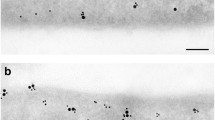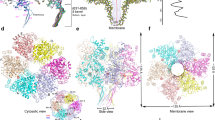Abstract
Helicobacter pylori (H. pylori) possesses an intrabacterial nanotransportation system (ibNoTS) for transporting CagA and urease within the bacterial cytoplasm; this system is controlled by the extrabacterial environment. The transportation routes of the system have not yet been studied in detail. In this study, we demonstrated by immunoelectron microscopy that CagA localizes closely with the MreB filament in the bacterium, and MreB polymerization inhibitor A22 obstructs ibNoTS for CagA. These findings indicate that the route of ibNoTS for CagA is closely associated with the MreB filament. Because these phenomena were not observed in ibNoTS for urease, the route of ibNoTS for CagA is different from that of ibNoTS for urease as previously suggested. We propose that the route of ibNoTS for CagA is associated with the MreB filament in H. pylori.








Similar content being viewed by others
References
Hong W, Sano K, Morimatsu S, Scott DR, Weeks DL, Sachs G, Goto T, Mohan S, Harada F, Nakajima N, Nakano T (2003) Medium pH dependent redistribution of the urease of Helicobacter pylori. J Med Microbiol 52:211–216
Wu H, Nakano T, Daikoku E, Morita C, Kohno T, Lian HH, Sano K (2005) Intrabacterial proton-dependent CagA transport system in Helicobacter pylori. J Med Microbiol 54:1117–1125
Cudmore S, Reckmann I, Way M (1997) Viral manipulations of the actin cytoskeleton. Trends Microbiol 5:142–148
Greber UF (2005) Viral trafficking violations in axons: the herpesvirus case. PNAS 102:5639–5640
Gerits N, Mikalsen T, Kostenko S, Shiryaev A, Johannessen M, Moens U (2007) Modulation of F-actin rearrangement by the cyclic AMP/cAMP-dependent protein kinase (PKA) pathway is mediated by MAPK-activated protein kinase 5 and requires PKA-induced nuclear export of MK5. J Biol Chem 282:37232–37243
Hehnly H, Stamnes M (2007) Regulating cytoskeleton-based vesicle motility. FEBS Lett 581:2112–2118
Dauty E, Verkman AS (2005) Actin cytoskeleton as the principal determinant of size-dependent DNA mobility in cytoplasm: a new barrier for non-viral gene delivery. J Biol Chem 280:7823–7828
Bohn W, Rutter G, Hohenberg H, Mannweiler K, Nobis P (1986) Involvement of actin filaments in budding of measles virus: studies on cytoskeletons of infected cells. Virology 149:91–106
Bucher D, Popple S, Baer M, Mikhail A, Gong YF, Whitaker C, Paoletti E, Judd A (1989) Antigenic analysis and intracellular localization with monoclonal antibodies. J Virol 63:3622–3633
De BP, Burdsall AL, Banerjee AK (1993) Role of cellular actin in human parainfluenza virus type 3 genome transcription. J Biol Chem 268:5703–5710
Shih YL, Rothfield L (2006) The bacterial cytoskeleton. Microbiol Mol Biol Rev 70:729–754
van den Ent F, Amos LA, Löwe J (2001) Prokaryotic origin of the actin cytoskeleton. Nature 413:39–44
Kürner J, Frangakis AS, Baumeister W (2005) Cryo-Electron tomography reveals the cytoskeletal structure of spiroplasma melliferum. Science 37:436–438
Divakaruni AV, Baida C, White CL, Gober JW (2007) The cell shape proteins MreB and MreC control cell morphogenesis by positioning cell wall synthetic complexes. Mol Microbiol 66:174–188
Errington J (2003) The bacterial actin cytoskeleton. ASM News 69:608–614
Nakano T, Aoki H, Wu H, Fujioka Y, Nakazawa E, Sano K (2012) Fine visualization of filamentous structures in the bacterial cytoplasm. J Microbiol Mehotds 60:60–64
Iwai N, Nagai K, Wachi M (2002) Novel S-benzylisothiourea compound that induces spherical cells in Escherichia coli probably by acting on a rod-shape-determining protein(s) other than penicillin-binding protein 2. Biosci Biotechnol Biochem 66:2658–2662
Iwai N, Ebata T, Nagura H, Kitazume T, Nagai K, Wachi M (2004) Structure-activity relationship of S-benzylisothiourea derivatives to induce spherical cells in Escherichia coli. Biosci Biotechnol Biochem 68:2265–2269
Iwai N, Fujii T, Nagura H, Wachi M, Kitazume T (2007) Structure-activity relationship study of the bacterial actin-like protein MreB inhibitors: effects of substitution of benzyl group in S-benzylisothiourea. Biosci Biotechnol Biochem 71:246–248
Noguchi N, Yanagimoto K, Nakaminami H, Wakabayashi M, Iwai N, Wachi M, Sasatsu M (2008) Anti-infectious effect of S-benzylisothiourea compound A22, which inhibits the actin-like protein, MreB, in Shigella flexneri. Biol Pharm Bull 31:1327–1332
Isenberg HD (2004) Preperation of broth microdilution mic trays. 5.15. clinical microbiology procedures hand book, 2nd Edn
Hong W, Morimatsu S, Goto T, Sachs G, Scott DR, Weeks DL, Kohno T, Morita C, Nakano T, Fujioka Y, Sano K (2000) Contrast-enhanced immunoelectron microscopy for Helicobacter pylori. J Microbiol Meth 42:121–127
Covacci A, Telford JL, Giudice GD, Parsonnet J, Rappuoli R (1999) Helicobacter pylori virulence and genetic geography. Science 284:1328–1333
Backert S, Ziska E, Brinkmann V, Zimny-Arndt U, Fauconnier A, Jungblut PR, Naumann M, Meyer TF (2000) Translocation of the Helicobacter pylori CagA protein in gastric epithelial cells by a type IV secretion apparatus. Cell Microbiol 2:155–164
Backert S, Moese S, Selbach M, Brinkmann V, Meyer TF (2001) Phosphorylation of tyrosine 972 of the Helicobacter pylori CagA protein is essential for induction of a scattering phenotype in gastric epithelial cells. Mol Microbiol 42:631–644
McGowan CC, Cover TL, Blaser MJ (1996) Helicobacter pylori and gastric acid: biological and therapeutic implications. Gastroenterology 110:926–938
Scott DR, Weeks D, Hong C, Postius S, Melchers K, Sachs G (1998) The role of internal urease in acid resistance of Helicobacter pylori. Gastroenterology 114:8–70
Skouloubris S, Thiberge JM, Labigne A, De Reuse H (1998) The Helicobacter pylori UreI protein is not involved in urease activity but is essential for bacterial survival in vivo. Infect Immun 66:4517–4521
Scott DR, Marcus EA, Weeks DL, Lee A, Melchers K, Sachs G (2000) Expression of the Helicobacter pylori ureI gene is required for acidic pH activation of cytoplasmic urease. Infect Immun 68:470–477
Weeks DL, Eskandari S, Scott DR, Sachs G (2000) A H+-gated urea channel: the link between Helicobacter pylori urease and gastric colonization. Science 287:482–485
Weeks DL, Sachs G (2001) Sites of pH regulation of the urea channel of Helicobacter pylori. Mol Microbiol 40:1249–1259
Mollenhauer-Rektorschek M, Hanauer G, Sachs G, Melchers K (2002) Expression of UreI is required for intragastric transit and colonization of gerbil gastric mucosa by Helicobacter pylori. Res Microbiol 153:659–666
Wu H, Nakano T, Matsuzaki Y, Ooi Y, Kohno T, Ishihara S, Sano K (2014) A new type of intrabacterial nanotransportation system for VacA in Helicobacter pylori. Med Mol Morphol 47:224–232
Aoki H, Wu H, Nakano T, Ooi Y, Daikoku E, Kohno K, Matsushita T, Sano K (2009) Nanotransportation system for cholera toxin in Vibrio cholerae O1. Med Mol Morphol 42:40–46
Shaevitz JW, Gitai Z (2010) The Structure and function of bacterial actin homologs. Cold Spring Harb Perspect Biol 2:a000364
Jones LJ, Carballido-López R, Errington J (2001) Control of cell shape in bacteria: helical, actin-like filaments in Bacillus subtilis. Cell 23:913–922
Celler K, Koning RI, Koster AJ, van Wezel GP (2013) Multidimensional view of the bacterial cytoskeleton. J Bacteriol 195:1627–1636
Beier D, Spohn G, Rappuoli R, Scarlato V (1997) Identification and characterization of an operon of Helicobacter pylori that is involved in motility and stress adaptation. J Bacteriol 179:4676–4683
Schweinitzer T, Mizote T, Ishikawa N, Dudnik A, Inatsu S, Schreiber S, Suerbaum S, Aizawa S, Josenhans C (2008) Functional characterization and mutagenesis of the proposed behavioral sensor TlpD of Helicobacter pylori. J Bacteriol 190:3244–3255
Nakamura H, Yoshiyama H, Takeuchi H, Mizote T, Okita K, Nakazawa T (1998) Urease plays an important role in the chemotactic motility of Helicobacter pylori in a viscous environment. Infect Immun 66:4832–4837
Scott DR, Marcus EA, Wen Y, Oh J, Sachs G (2007) Gene expression in vivo shows that Helicobacter pylori colonizes an acidic niche on the gastric surface. Proc. Natl Acad Sci USA 104:7235–7240
Mizote T, Yoshiyama H, Nakazawa T (1997) Urease-independent chemotactic responses of Helicobacter pylori to urea, urease inhibitors, and sodium bicarbonate. Infect Immun 65:1519–1521
Doi M, Wachi M, Ishino F, Tomioka S, Ito M, Sakagami Y, Suzuki A, Matsuhashi M (1988) Demonstrations of the DNA sequence of the MreB gene and of the gene products of the mre region that function in formation of the rod shape of Escherichia coli cells. J Bacteriol 170:4619–4624
Srivastava P, Demarre G, Karpova TS, McNally J, Chattoraj DK (2007) Changes in nucleoid morphology and origin localization upon inhibition or alteration of the actin homolog, MreB, of Vibrio cholera. J Bacteriol 189:7450–7463
Abhayawardhane Y, Stewart GC (1995) Bacillus subtilis possesses a second determinat with extensive sequence similarity to the Escherichia coli mreB morphogene. J Bacteriol 177:765–773
Popp D, Narita A, Maeda K, Fujisawa T, Ghoshdastider U, Iwasa M, Maéda Y, Robinson RC (2010) Filament structure, organization, and dynamics in MreB sheets. J Biol Chem 285:15858–15865
Dempwolff F, Reimold C, Reth M, Graumann PL (2011) Bacillus subtilis MreB orthologs self-organize into filamentous structures underneath the cell membrane in a heterologous cell system. PLoS One 6:e27035
Gahlmann A, Moerner WE (2014) Exploring bacterial cell biology with single-molecule tracking and super-resolution imaging. Nat Rev Microbiol 12:9–22
Madabhushi R, Marians KJ (2009) Actin homologue MreB affects chromosome segregation by regulating topoisomerase IV in Escherichia coli marians. Mol Cell 33:171–180
Soufo CD, Soufo HJ, Noirot-Gros MF, Steindorf A, Noirot P, Graumann PL (2009) Cell-cycle-dependent spatial sequestration of the DnaA replication initiator protein in Bacillus subtilis. Dev Cell 15:935–941
Acknowledgments
We thank Mr. Yoshihiko Fujioka of the Department of Microbiology and Infection Control, Osaka Medical College, and Mr. Rintaro Oide of the Department of Central Research Laboratory, Osaka Medical College, for their technical help. We also thank Mrs. Hiroko Oki and Mrs. Kanako Kira for their support.
Author information
Authors and Affiliations
Corresponding author
Rights and permissions
About this article
Cite this article
Wu, H., Iwai, N., Nakano, T. et al. Route of intrabacterial nanotransportation system for CagA in Helicobacter pylori . Med Mol Morphol 48, 191–203 (2015). https://doi.org/10.1007/s00795-015-0097-0
Received:
Accepted:
Published:
Issue Date:
DOI: https://doi.org/10.1007/s00795-015-0097-0




